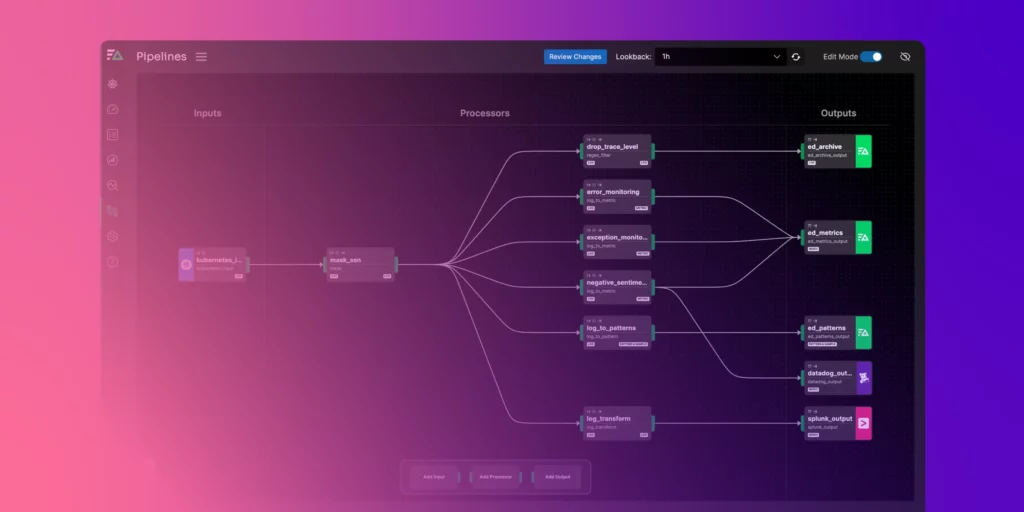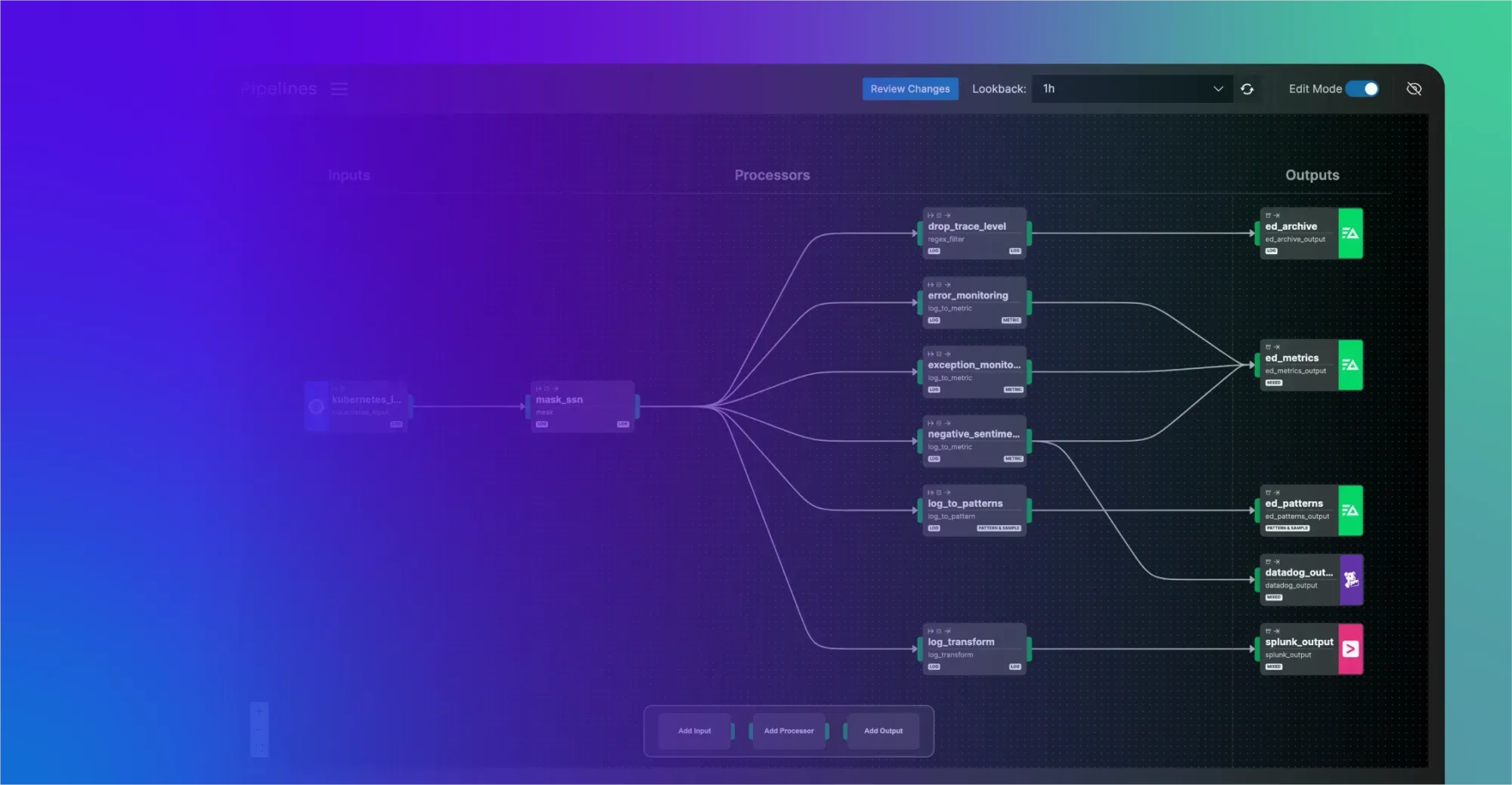At Edge Delta, our mission is to ensure that developers and DevOps teams have the most seamless experience possible when navigating mission-critical observability data. As CTO, I see firsthand how vital it is for teams to rapidly understand and act on the telemetry they collect. When issues arise in production — or when teams undergo heavy telemetry usage — the last thing they need is a convoluted or overly complicated interface. That’s why we invest heavily in both product design and engineering: to reduce cognitive load and empower teams to operate at peak efficiency.
Below are the key product and engineering principles we follow to achieve our vision of “effortless observability”:
1. Make Aggregated Data Clickable for Deeper Insight
2. Provide Comparison Values for All Aggregated Data
3. Provide Instant Feedback for Monitor Tuning
4. Synchronize Context for Accelerated Root-Cause Analysis
In the rest of this article, we’ll dig deeper into each of these points to explain their value.
1. Make Aggregated Data Clickable for Deeper Insights
Why It Matters
Aggregated data (e.g., totals, averages, sums) answers high-level questions quickly, but it shouldn’t be the end of the story. Teams often need to dig deeper — maybe they want to know how many agents are running a specific version, or how a data point changes across different segments of the environment.
Our Approach
- Interactive Breakdowns: Every metric or aggregated result in our dashboards is clickable, leading to an exploration page where users can slice and dice data further.
- Flexible Queries: From that exploration page, users can pivot, filter, or regroup data according to their needs. It’s the ultimate safety net for those “Wait, but what about…” questions.
Engineering Investment
To power this level of interactivity, we’ve built a scalable back-end query engine designed for rapid data retrieval. Our architecture supports real-time exploration without sacrificing performance, even under heavy loads.
2. Provide Comparison Values for All Aggregated Data
Why It Matters
A metric in isolation can be misleading. For instance, seeing “45 GB of data from a particular source” doesn’t hold much meaning unless you know how that compares to yesterday, last week, or the same time last month.
Our Approach
- Built-In Comparisons: We automatically include comparison data — be it day-over-day or week-over-week — alongside key metrics. This helps our customers immediately gauge trends and anomalies.
- Configurable Lookback Windows: Users can choose custom lookback periods to align comparisons with their release cycles or relevant business metrics, ensuring the context is always right for their workflow.
Engineering Investment
Offering comparison values at scale requires storing and indexing historical data efficiently. Our engineering team has invested in highly performant time-series databases and indexing strategies, enabling us to serve these comparisons in near real time.
3. Provide Instant Feedback for Monitor Tuning
Why It Matters
Configuring anomaly detectors can be challenging. Sensitivity requirements often vary by environment and workload maturity — a single default setting simply doesn’t work for everyone.
Our Approach
- Sensitivity Slider: We introduced a slider that instantly recalculates potential anomalies using historical data. Users can immediately see how many anomalies a certain setting would have generated in the past.
- Real-Time Iteration: This instant feedback loop allows teams to fine-tune their settings without guesswork. They can dial sensitivity up or down to match their unique environment — whether it’s a stable, mature product or a fast-evolving development environment.
Engineering Investment
Under the hood, our anomaly detection engine must recalculate historical data on the fly, requiring significant optimization. Our engineering teams have worked hard to ensure these calculations are lightning-fast and accurate, providing a smooth user experience at scale.
4. Synchronize Context for Accelerated Root-Cause Analysis
Why It Matters
Time is of the essence when troubleshooting system issues. If a developer can’t quickly piece together relevant data across multiple dashboards, the fallout could mean prolonged outages and lost productivity.
Our Approach
- Synchronize: We work tirelessly to reduce manual correlation efforts by linking related telemetry data. For instance, when a user hovers over a point in one chart, matching time ranges in other charts are highlighted to quickly connect the dots.
- Intuitive Tooltip Freezing: With highly dense charts, developers often need to “freeze” tooltips to examine a particular data point. A simple click lets them lock that moment in time, revealing more context and letting them dive deeper without sifting through extraneous information.
Putting Ourselves in Our Customers’ Shoes
Ultimately, delivering top-tier observability isn’t just about building robust engineering solutions — it’s also about delivering a thoughtful user experience. We firmly believe that observability is not merely an “engineering problem.” Instead, it’s the intersection of strong engineering and intuitive design that creates a frictionless environment for our customers.
At Edge Delta, we remain committed to continuous innovation and collaboration. Our product and engineering teams work hand in hand to craft solutions that minimize cognitive load, speed up root-cause analysis, and make any aggregated data instantly actionable. By putting ourselves in our customers’ shoes, we ensure that every feature we release carries real-world impact — and brings us one step closer to truly effortless observability.






